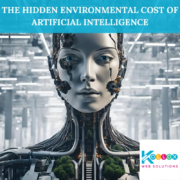The Hidden Environmental Cost of Artificial Intelligence
Artificial Intelligence (AI) has completely transformed our world, revolutionizing industries such as healthcare, finance, education, web design, marketing and transportation. From using ChatGPT to write emails to generating images with AI tools like Stable Diffusion, AI’s rapid advancements have become deeply integrated into our daily lives. However, this technological advancement comes with a significant and overlooked, cost: its environmental impact.
While AI promises to make our lives easier and more efficient, the question arises……at what cost to the planet earth?
The Carbon Footprint of AI
Every time we use AI, whether it’s to summarize a report or generate a digital image, there’s an environmental price to pay. The energy required to power these AI systems is substantial, and with that energy consumption comes a significant amount of carbon emissions. For instance, generating a single AI image consumes as much energy as fully charging your smartphone. A recent report from AI start-up Hugging Face and Carnegie Mellon University highlighted that training a large AI model like GPT-3 can emit as much as 502 tonnes of carbon which is the equivalent to the annual emissions of driving 112 gasoline-powered cars…..crazy isn’t it!
Training AI Models: The Hidden Energy Drain
Training AI models is an incredibly energy-intensive process. As AI models grow more complex, their computational demands skyrocket. For example, training a large language model (LLM) like GPT-4 requires exposure to datasets containing hundreds of billions of words, which demands vast amounts of energy. The larger the model, the greater the environmental burden, as these models must undergo extensive tuning and experimentation to achieve top-level performance. This relentless push for larger and more capable models drives up energy consumption and, consequently, carbon emissions.
Usage Costs: The Ongoing Environmental Toll
While the initial training of AI models is energy-intensive, the real environmental impact becomes apparent with their widespread usage. Popular AI models like ChatGPT are used millions of times per hour, and this continuous use quickly surpasses the carbon footprint of the initial training. For instance, generating 3,400 images with an AI model like Stable Diffusion XL is the equivalent to driving an average gasoline-powered car for 22.44 kilometers. Given that 34 million AI-generated images are created daily, the environmental cost is staggering and comparable to a car making 5.6 laps around the Earth every single day.
Specific Task Models vs. Large Multimodal Models
The energy consumption of AI varies depending on the type of task. Generating images or using large multimodal models, which perform multiple functions like generating and summarizing content, consumes far more energy than task-specific models designed for simpler tasks like classifying text. The inefficiency of using large models for smaller, specific tasks contributes significantly to AI’s carbon footprint. For example, classifying movie reviews with a multi-purpose model requires 30 times more energy than using a task-specific model.
The Carbon Footprint of Video AI: A Growing Concern
As we go deeper into the world of artificial intelligence, video AI is emerging as one of the most resource-intensive technologies. Unlike text-based AI models, which require considerable computational power, video AI demands even more energy due to the sheer volume of data it processes. Video AI involves analyzing, generating, and manipulating high-definition video content in real-time, which requires vast amounts of computational power and storage. This translates into a significant carbon footprint, far exceeding that of text or image-based AI.
For instance, training a video AI model to recognize objects, track movements, or generate realistic video content involves processing terabytes of data. Each frame of video is essentially an image that must be analyzed, and with standard video running at 30 to 60 frames per second, the computational load quickly becomes enormous. This load increases exponentially when dealing with high-definition or 4K video, which is becoming the standard in both consumer and industrial applications.
As video AI becomes more prevalent in applications like surveillance, autonomous driving, and entertainment, its environmental impact will likely grow. Each use of video AI not only requires significant energy but also contributes to the cumulative carbon emissions of the technology. The implications are clear: as video AI continues to develop, we must address its environmental costs.
The Future of Robotics and AI: Super-Powered Brains with Environmental Costs
Looking ahead, the future of robotics is poised to be revolutionized by AI, particularly as robots are equipped with increasingly sophisticated “brains” powered by advanced AI models. These robotic systems will be capable of performing complex tasks autonomously, from manufacturing and logistics to healthcare and even exploration of other planets. However, the super-powered brains of these robots will require immense computational power, which will inevitably lead to higher energy consumption and a larger carbon footprint.
As robotics advances, the integration of AI will allow robots to make real-time decisions, adapt to new situations, and learn from their environment, all of which demand continuous processing of vast amounts of data. For instance, a robot navigating a dynamic environment will need to process visual, auditory, and sensory information simultaneously, requiring a powerful AI-driven system to interpret and respond to these inputs in real-time. This level of processing not only requires sophisticated hardware but also relies on energy-intensive AI models, further contributing to carbon emissions.
The future of robotics, with its super-powered AI brains, presents a dual challenge. On one hand, these advancements hold the promise of incredible innovations that can transform industries and improve our quality of life. On the other hand, the environmental cost of powering these intelligent systems cannot be ignored. As we continue to push the boundaries of what AI and robotics can achieve, it will be crucial to develop sustainable practices that minimize their carbon footprint.
What Can Be Done?
As AI continues to integrate into our lives, the environmental impact of its usage will only grow. It’s crucial for both users and developers to consider the sustainability of AI. Large organizations that own AI compute resources must prioritize environmental sustainability by shifting to renewable energy sources and reducing their carbon footprint. For individual users, understanding the carbon cost of their AI usage and making more conscious decisions about when and how to use AI tools can contribute to mitigating the overall environmental impact.
AI has the potential to enhance our lives in countless ways, but its environmental cost is a raising concern. The energy consumption and carbon emissions associated with training and using AI models are substantial and growing. As we continue to embrace AI, it is essential to balance innovation with sustainability, ensuring that the benefits of AI do not come at an untenable cost to our planet. The future of AI must include a focus on reducing its carbon footprint, making technological advancement and environmental responsibility go hand in hand.





Leave a Reply
Want to join the discussion?Feel free to contribute!